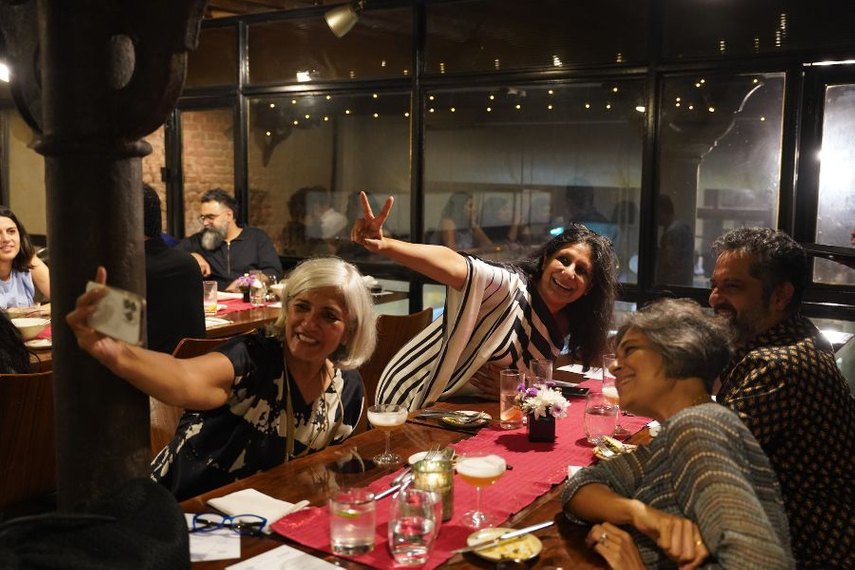
When Mumbai-based Gauri Devidayal and her husband, Jay Yousuf, launched ‘The Table’ in Mumbai in 2011, they intentionally ditched the white-tablecloth fine-dining formula. Instead, they introduced a one-page menu focused on honest, ingredient-driven food.
This commitment to authenticity has kept their regulars returning for over a decade. “The last 14 years have seen regulars walk through the doors every week,” Devidayal, co-founder of Food Matters Group, told Campaign.
Earlier this year, ‘The Table’ underwent a transformation—dubbed 'The Table 2.0’—with Chef Will Aghajanian at the helm. Yet, the essence of their brand remained intact: fun, fuss-free dining with elevated techniques.
This steadfastness, paired with refreshed branding that complements their culinary evolution, has cemented their reputation. As Devidayal noted, “When you stand for what you are truly passionate about, offer honest food, and great service, customer loyalty is a given.”

Similarly, Nara Thai leans on authenticity as its cornerstone. From replicating traditional Thai menu designs to importing key ingredients directly from Bangkok, the brand under Aditya Birla New Age Hospitality ensures its patrons experience genuine Thai culture.
“Everything we do signals our deep roots in Thailand,” said the restaurant chain’s CEO, Udai Pinnali. This extends beyond the plate, with staff greeting guests with a cheerful “Sawadee-kha” (Welcome in Thai) and the celebration of Thai festivals like Songkran and Loy Krathong.
India's food services industry is cooking up a storm, set to grow at a robust 8.1% CAGR from 2024 to 2028, as per the National Restaurant Association of India. Currently valued at INR 5.7 lakh crores (FY24), it's poised to hit INR 7.8 lakh crores by FY28.
Dining habits are evolving too—Indians now eat out or order in 7.9 times monthly, up from 6.6 in 2019. Of these, 3.7 are dine-outs, while 4.2 involve ordering in. With consumer palates expanding, the industry’s plate is getting fuller and tastier.
However, while the world of dining out is a jungle teeming with options, yet only a few restaurant brands manage to carve out a lasting space in the minds—and hearts—of diners.

As consumers increasingly seek not just meals but memorable experiences, branding has evolved into the ultimate weapon for restaurants aiming to thrive in an oversaturated market. Gone are the days when great food alone could guarantee success; today, it’s the story, the vibe, and the promise of something unique that reel customers in.
In a crowded dining ecosystem where even the most niche cuisines have numerous contenders, restaurateurs like Devidayal and Pinnali exemplify how investing in clear brand identities can build lasting loyalty among premium clientele. Meanwhile, branding agencies are working behind the scenes to craft brand stories that are more than skin deep.
Standing out through identity
Crafting a memorable restaurant brand isn’t just about creating a logo or choosing a colour palette. It’s about storytelling.
Anneka Dave Parekh, founder of turnkey branding agency, House of Inara, believes that for high-end restaurants, branding is about weaving intangibles like ambiance and service ethos into a cohesive experience. “These factors create immersive experiences that linger long after the meal, setting a restaurant apart,” she explained.
For Rahul Tekwani, managing partner of Branding Edge Strategies, the magic lies in first impressions. “Jerry Maguire famously said, ‘You had me at hello.’ In the restaurant business, if you don’t make that first impression count, you’ve lost them,” he said.
However, relying solely on a famous name or celebrity buzz can be a double-edged sword. While it can get the initial footfalls because of the novelty factor, these often fail to generate lasting loyalty. Instead, a niche focus—whether on a specific cuisine or high-value audience—helps build meaningful connections with diners.

Ronita Mukherjee, executive client director at Landor India, argued that effective branding is all about consistency. “Positioning is storytelling,” she said. "Think of the most premium restaurants globally—they’re memorable because of something unique, whether it’s a celebrity chef, location, or theatrical service rituals." For restaurants, embracing simplicity and avoiding trend-chasing can ensure their brand resonates over time.
Learning from mistakes
Even the best-intentioned branding strategies can go awry. Mukherjee pointed out that many high-end restaurants rely on overused buzzwords like ‘farm-to-table’ or ‘fusion cuisine’, which dilute authenticity. She also highlighted the importance of excellent service, noting, “Poor service can ruin even the best-tasting meals.”
Parekh echoed this sentiment, advising restaurants to avoid appealing to too broad an audience. “High-end restaurants must remember that less is often more,” she said.
Neglecting service quality or relying too heavily on flashy promotions can damage a brand's exclusivity. True luxury, she believes, thrives on subtlety and word-of-mouth.
Tekwani underscored the importance of focus. “The most common mistake I see is restaurants trying to do too many things to be different,” he said.
Overcomplicating a brand or tweaking authentic recipes to suit local palates often backfires. Instead, restaurants should specialise in what they do best and resist the temptation to cater to everyone.

Ensuring consistency across all customer touchpoints—whether online or in-house—is non-negotiable for high-end restaurants. Devidayal noted that both ‘The Table’ and ‘Mag St.’ focus on approachable, comfort dining. From honest social media communication to thoughtfully designed packaging, the philosophy is clear: what you see is what you get.
For Pinnali, consistency at Nara Thai extends to every detail, including its digital presence, staff training, and even the restaurant's signature fragrance. “Each touchpoint amplifies our story of authentic Thai cuisine,” he said.
The future of restaurant branding lies in multi-sensorial experiences where restaurateurs think beyond logos and colour schemes. “What’s the sound of your brand? How does it smell? Have you thought about service rituals?” Mukherjee asked. She also stressed the importance of blending high-tech and high-touch approaches to create efficient yet memorable dining experiences.
Experiences over meals: The new social currency
Pinnali highlighted the risk of over-luxuriating a brand, which can alienate potential customers. “A common pitfall is making the brand feel too exclusive, which can make it seem unapproachable,” he said. He advised striking a balance between premium quality and a welcoming atmosphere.

Similarly, Devidayal cautioned against opening restaurants without a clear vision. “Trying to open a restaurant only to appeal to tourists who may come once often falls flat,” she said. Instead, she advocated creating spaces with heart and soul that resonate with locals.
Today, dining is about more than food—it’s about fuelling people’s desire for new and unexplored experiences. Limited seating, exclusive reservations, and intimate pop-ups are ways premium restaurants are marketing themselves. “It’s the promise of an experience, sometimes the ones you need to wait for,” Mukherjee said.
For high-end restaurants navigating an increasingly competitive market, the key lies in blending authenticity, consistency, and creativity. Whether it’s a one-page menu, a signature greeting, or a thoughtfully curated ambiance, the little things matter. After all, in a world where choices abound, only the most memorable brands endure.


.jpg&h=334&w=500&q=100&v=20250320&c=1)
.jpg&h=334&w=500&q=100&v=20250320&c=1)



.jpg&h=334&w=500&q=100&v=20250320&c=1)
.jpg&h=334&w=500&q=100&v=20250320&c=1)


.jpg&h=334&w=500&q=100&v=20250320&c=1)

.jpg&h=268&w=401&q=100&v=20250320&c=1)



.jpg&h=268&w=401&q=100&v=20250320&c=1)


